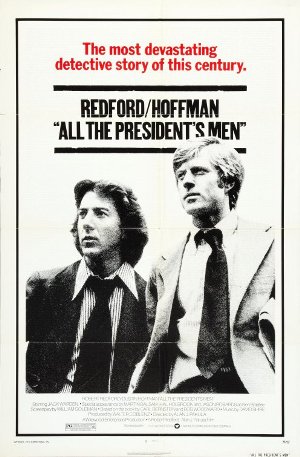Alan Pakula’s 1976 drama All The President’s Men is a starkly realistic look at the investigation of the Watergate scandal by Washington Post journalists Carl Bernstein (Dustin Hoffman) and Bob Woodward (Robert Redford).
When five men are arrested for breaking into the headquarters of the Democratic National Convention in Washington, D.C. with wiretapping equipment, Woodward is the first to the courthouse. The shocking revelation that one of them has been paid by former CIA and President’s Special Council members urges he and Bernstein to dig further, uncovering a disturbing chain of command that runs all the way to President Nixon. 
In a time when the country’s involvement in Vietnam and the Civil Rights Movement occupied newspaper headlines, it was a difficult task to get the scraps of information that became the Watergate scandal onto the front page. Woodward and Bernstein (or “Woodstein,” as editor Ben Bradlee (Jason Robards) called them) had to engage in a roundabout sort of investigative journalism, taking silence as answers and toeing the line between fact and speculation.
All The President’s Men was revolutionary in showing a gritty, sober film about journalism. The Watergate scandal’s severity is sometimes glossed over by the bumbling, caricatured form of President Nixon, a frequent feature of political satire. But Pakula drove home not only the purely criminal acts committed by the President and his confidantes, but also the danger that Bernstein and Woodward were in as journalists undermining the cover-up efforts of the FBI, CIA, and the White House.
This tension wouldn’t have existed if the relationship between Bernstein and Woodward had followed the direction of the duo in your typical “buddy film.” And yes, this is one. It’s difficult to tell because the supportive, sometimes opposing, playful (though reserved), and budding friendship between the two leads is hidden in the dialogue.
The key moment that evidences this relationship occurs in the car after a questionable interview with Judy Hoback Miller (Jane Alexander), an informant who worked at the Committee to Re-elect the President. Bernstein wants to write that there is a cover-up, but hasn’t received sufficient evidence from Miller. Woodward thinks he needs more evidence to support his claim.
Bernstein constructs a metaphor: if you get in a car and there’s music playing on the radio for ten minutes, what can you deduce from that – is it AM or FM?
Woodward counters with his own: if a guy comes up to me on a street and asks me an address, is he interrogating me or is he just lost?
Both metaphors speak to the same issue: deduction without proper facts, the key to a journalist’s – and a paper’s – fame or infamy. But they are about the closest incident of direct conflict between the two. It’s clear they’re divided on the issue, but to see how is difficult. A few other incidents from earlier in the film can help us understand just what their individual sentiments are – the first time they visit Miller’s house, Bernstein opens with a request to come in and ask some questions. Woodward, on the contrary, reaches out a hand and says they don’t have to go into her house.
When a co-worker, Kay Eddy (Lindsay Crowne) is discovered to have been in a relationship with a potential source, Woodstein try to get her to coax the information from him. Eddy is resistant, but Bernstein insists. Woodward, against his colleague’s intention, backs down, saying Eddy doesn’t have to talk to him if she doesn’t want to.
Even in their first interaction, when Bernstein steals Woodward’s notes and begins writing on them, Woodward approaches and tells him: “It’s not what you did, but the way you did it.”
It’s clear that the two don’t agree on investigative methods. But their reasoning behind it is more psychological; it comes from their relations with people in general. Bernstein’s earlier analogy, while attempting to explain the same issue as Woodward’s, is different in one key aspect: it doesn’t involve human interaction.
Bernstein compares the questioning process to listening to a radio; Woodward draws a connection to another kind of conversation, an interpretation of a stranger’s question. The two reporters are polar opposites, but they work so closely that even their metaphors are similar – though they defend two completely different sides of the same argument.
Pakula, who was considered an “actor’s director” and known for how deftly he could interpret the workings of the mind, chose to keep their opposition to each other understated. To that end, so was their affection and willingness to work together. And it certainly helped that William Goldman wrote the screenplay – perhaps you remember him for another buddy film, Butch Cassidy and the Sundance Kid?
When they want specific names from Miller, it’s Bernstein who proposes they play off each other, having Woodward cut him off and open a dialogue between each other instead of just them and her. Whenever they get a lead, they share a laugh and sometimes almost a friendly spar. Bernstein once throws Woodward a cookie; the latter catches it and chuckles, saying he doesn’t want one. Even then, they still oppose, but it’s subtle, mellow. It’s natural.
In this way All The President’s Men manages to reveal an intimate working relationship amidst “the most devastating detective story of [that] century.” But the “buddy” back and forth of Woodstein never overshadows the underlying corruption that is corroding the federal government – and the wits of the Washington Post’s two sharpest reporters. Without alerting them to the coming masterpiece, Pakula and Goldman created a classic duo right under the audience’s (and Nixon’s) nose.


